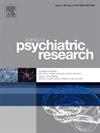The moderating effect of recent positive and negative life events on the impact of early life stress on mental wellbeing and distress
IF 3.7
2区 医学
Q1 PSYCHIATRY
引用次数: 0
Abstract
Early life stress (ELS) significantly influences mental health in later stages of life. Yet it is unclear whether recent life events lessen or intensify the effects of ELS on present wellbeing and distress. We addressed this question in 1064 healthy community adults with a normative range of wellbeing and distress. We tested whether recent daily life events (DLE), occurring in the 12 months prior to assessment, moderated the association between effects of past ELS on present wellbeing and distress. Principal components analysis was first used on both ELS and DLE to determine the event types loading together on components. For wellbeing, we observed associations with the ELS component ‘family conflict’, and DLE components ‘positive work changes’, ‘positive lifestyle changes’, ‘vacation’, and ‘negative work changes’. There was no evidence of these DLEs moderating the relationship between ELS and wellbeing. For distress, we found associations with three ELS components, ‘interpersonal violence’, ‘personal health trauma’, and ‘peer conflict’, of which ‘interpersonal violence’ showed an interaction with two negative DLE components – ‘relationship problems’ and ‘sexual/pregnancy difficulties’. These findings suggest that the pervasive impact of interpersonal violence (childhood physical, sexual, and emotional abuse) on psychological distress is further compounded by maladaptive relationships in adulthood, which lead to higher distress; however, for wellbeing, the effects of ELS and DLE are independent. Our findings indicate a complex pattern of associations between life events and mental health, and highlight the importance of examining both wellbeing and distress outcomes, which may vary depending on the associations between early and recent life events.
近期积极和消极生活事件对早期生活压力对心理健康和痛苦影响的调节作用。
早期生活压力(ELS)显著影响生命后期的心理健康。然而,目前尚不清楚最近的生活事件是否会减轻或加剧ELS对当前健康和痛苦的影响。我们在1064名健康的社区成年人中解决了这个问题,他们的幸福和痛苦都是标准的。我们测试了在评估前12个月内发生的最近的日常生活事件(DLE)是否调节了过去的ELS对当前健康和痛苦的影响之间的关联。主成分分析首先在ELS和DLE上使用,以确定在组件上一起加载的事件类型。对于幸福感,我们观察到ELS成分“家庭冲突”和DLE成分“积极的工作改变”、“积极的生活方式改变”、“假期”和“消极的工作改变”之间的联系。没有证据表明这些dle会调节ELS和幸福感之间的关系。对于痛苦,我们发现与三个ELS组成部分,“人际暴力”,“个人健康创伤”和“同伴冲突”有关,其中“人际暴力”与两个消极的DLE组成部分-“关系问题”和“性/怀孕困难”相互作用。这些发现表明,人际暴力(童年时期的身体、性和情感虐待)对心理困扰的普遍影响,会因成年后的不适应关系而进一步加剧,从而导致更高的困扰;然而,对于健康而言,ELS和DLE的影响是独立的。我们的研究结果表明,生活事件与心理健康之间存在复杂的关联模式,并强调了检查幸福和痛苦结果的重要性,这可能因早期和近期生活事件之间的关联而有所不同。
本文章由计算机程序翻译,如有差异,请以英文原文为准。
求助全文
约1分钟内获得全文
求助全文
来源期刊

Journal of psychiatric research
医学-精神病学
CiteScore
7.30
自引率
2.10%
发文量
622
审稿时长
130 days
期刊介绍:
Founded in 1961 to report on the latest work in psychiatry and cognate disciplines, the Journal of Psychiatric Research is dedicated to innovative and timely studies of four important areas of research:
(1) clinical studies of all disciplines relating to psychiatric illness, as well as normal human behaviour, including biochemical, physiological, genetic, environmental, social, psychological and epidemiological factors;
(2) basic studies pertaining to psychiatry in such fields as neuropsychopharmacology, neuroendocrinology, electrophysiology, genetics, experimental psychology and epidemiology;
(3) the growing application of clinical laboratory techniques in psychiatry, including imagery and spectroscopy of the brain, molecular biology and computer sciences;
 求助内容:
求助内容: 应助结果提醒方式:
应助结果提醒方式:


